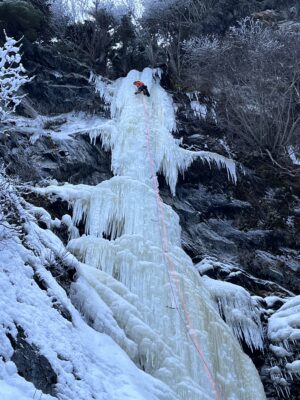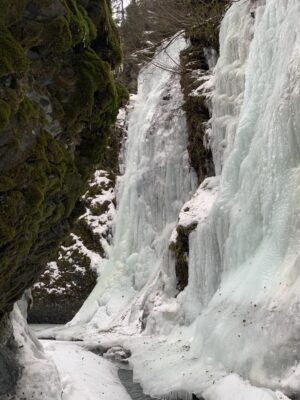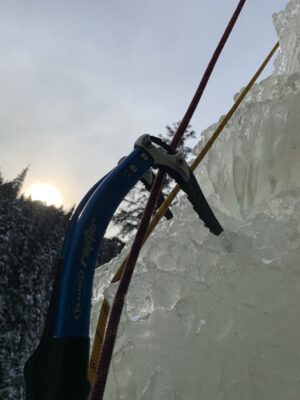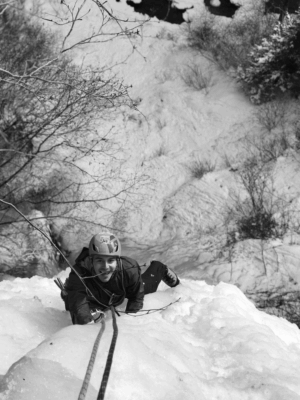 Many areas in the Kenai Mountains have a wealth of history. Victor Creek is one of them. Today, a trail runs along its north rim, with new extensions heading both north and south, and a recently added footbridge. It is crossed by the Alaska Railroad and pours into Kenai Lake—both of which are tied to early travel methods in the area before roads.
Many areas in the Kenai Mountains have a wealth of history. Victor Creek is one of them. Today, a trail runs along its north rim, with new extensions heading both north and south, and a recently added footbridge. It is crossed by the Alaska Railroad and pours into Kenai Lake—both of which are tied to early travel methods in the area before roads.
The area also has a rich history of mining, and it remains active to this day. In more modern times, ice climbers have searched this narrow and steep canyon for ephemeral ice lines that drip from the rim. Like the miners before them, they navigate its walls and wind around its corners in search of a mother lode.
Even now, the canyon echoes with a familiar rhythm—a series of taps carried on the wind. In summer, it might be a miner swinging a hammer, pickaxe, or shovel—working the rock in hopes of striking it rich. In winter, it could be the precise swings of an ice climber’s tools biting into frozen walls. Different hands, different seasons, but the same careful music. In either case, success depends on being in tune—with your tools, your surroundings, and the sound of each deliberate strike.
 Trails line both rims of the canyon, but for ice climbers and the curious winter hiker, the creek itself is the path of choice—for both ease of access and the novelty factor. But don’t be fooled—the travel can be far from easy or straightforward. Right at the start, you might find yourself tiptoeing across thin bridges—or more likely, thin ice shelves that cling to overhanging rock walls several feet above the flowing water. Travel here mimics glacier navigation—probing each step, holding your breath, trying to feel weightless to avoid a sudden, frigid plunge.
Trails line both rims of the canyon, but for ice climbers and the curious winter hiker, the creek itself is the path of choice—for both ease of access and the novelty factor. But don’t be fooled—the travel can be far from easy or straightforward. Right at the start, you might find yourself tiptoeing across thin bridges—or more likely, thin ice shelves that cling to overhanging rock walls several feet above the flowing water. Travel here mimics glacier navigation—probing each step, holding your breath, trying to feel weightless to avoid a sudden, frigid plunge.
If you make it past the first few meandering corners, the travel becomes slightly easier, and you’ll come across one of the most spectacular vertical pitches of ice on the Kenai Peninsula: the King’s Beard. It often has more of a yellow color than the usual deep blue that the other formations have in the canyon. This is due to minerals seeping into the water. But perhaps the yellow color is symbolic of gold, since it is the prize ice in the canyon.
Rated WI5+, this proud line demands full focus and promises a full-value day for any climber. It is often overhanging in spots, with many ice bulges and small pillars of ice to navigate. It alone draws people into the canyon—climbers seeking a challenge, and hikers chasing beauty.
 After the King’s Beard, there are a couple of pinches in the canyon that can halt progress if the ice bridges don’t form well. Beyond the first constriction, people will find another named ice line. Juicy Route is named for its often wet, sticky ice that makes for easier climbing compared to the King’s Beard. Beyond here lies a series of unnamed climbs that pour into the second constriction, which can completely close off the canyon in some years. The rock here is unique in the way it has been carved out by the creek to resemble a wave.
After the King’s Beard, there are a couple of pinches in the canyon that can halt progress if the ice bridges don’t form well. Beyond the first constriction, people will find another named ice line. Juicy Route is named for its often wet, sticky ice that makes for easier climbing compared to the King’s Beard. Beyond here lies a series of unnamed climbs that pour into the second constriction, which can completely close off the canyon in some years. The rock here is unique in the way it has been carved out by the creek to resemble a wave.
Towards the back of the canyon lies a pool of forever-bubbling water from a final named ice climb: Jacuzzi. The history of the first ascent is that the climbers fell into the pool at the start, then finished the climb and ran back to the car while their gear and clothes were slowly freezing solid!
Whatever draws people to this canyon—now or long ago—one thing remains: it freezes for a fleeting moment, offering passage into this ephemeral world of frozen lodes. And then, in March and April of every year, it slowly resets. The water levels rise and continue to carve out the walls and deposit bits of gold that land in the pans and buckets of a lucky miner.
-Joseph Nyholm
Joe Nyholm has been associated with Mt. Marathon’s legend of Gumby – you are just as likely to see him on or off trail – he may or may not have a severe sensitivity to pushki.

